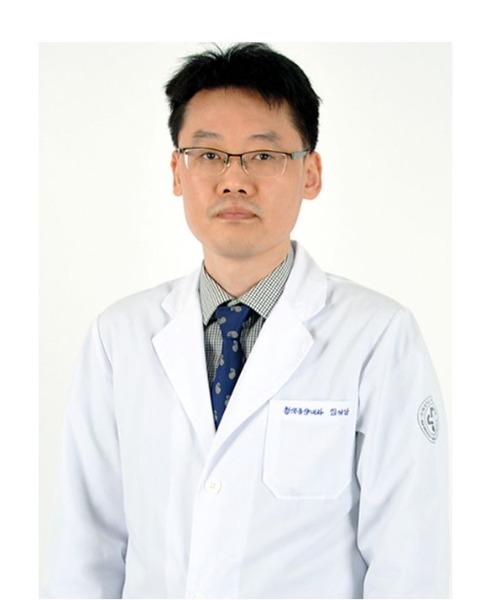Treatment of Newly Diagnosed Myeloma - Transplant Eligible
Poster Session 1
P-149: Follw-up of transplant-eligible multiple myeloma received Busulfan-based conditioing versus high-dose melphalan
Wednesday, September 27, 2023
1:30 PM - 2:30 PM EEST

Sung-Nam Lim
Associate professor
Inje University College of Medicine, Haeundae Paik Hospital
Busan, Pusan-jikhalsi, Republic of Korea
Introduction: We previously reported that there was no difference in PFS between the two groups receiving conditioning using busulfan-based and high-dose melphalan. These results showed that busulfan-based conditioning has high efficacy with manageable adverse events.
So, we followed up on the previously published data and conducted additional analyses focusing on biochemical and clinical relapse-related events. This retrospective study was performed to investigate the effectiveness and safety of busulfan, cyclophosphamide, and etoposide (BuCyE) versus high-dose melphalan, followed by ASCT.
Methods: A total of 35 patients who had been treated with remission induction for bortezomib, thalidomide, and dexamethasone (VTD) were enrolled between March 2016 and September 2021. The median age of enrolled patients was 57 years, ranging from 47 to 67 years. The conditioning regimens were as follows, the busulfan-based regimen was composed of busulfan 3.2 mg/kg from days -7 to days -5, etoposide 200 mg/m2 from days -5 to days -4, cyclophosphamide 50 mg/m2 from days -3 to days -2 and HEMEL conditioning regimen consisted of melphalan from 140 mg/m2 to 200 mg/m2.
Results: Revised international staging system (R-ISS) was shown as follows; stage I with 0 in BuCyE vs. 27.2% in HD-MEL, stage II with 84.6% in BuCyE vs. 68.1% in HD-MEL, and 15.4% in BuCyE vs. 4.5%, respectively.
The overall response rate before ASCT was 100% in both groups, including 76.9% in BuCyE and 63.6% in HDMEL with more than very good partial response, and 30.8% in BuCyE versus 40.9% in HDMEL with complete response, respectively. The median follow-up for the group was 38 months. The 3-year progression-free survival (PFS) was 51.2% for the HDMEL group versus 61.5% for the BuCyE group. PFS was analyzed by dividing it into biochemical relapse and clinical relapse. When disease progression is limited to clinical relapse, the median PFS was 56.8 months in HDMEL (95% CI, 26.1 to 87.4 months) and 38.3 months in BuCyE (95% CI, 27.9 to 48.6 months) (P=0.611). If an event of PFS contained both biochemical relapse and clinical relapse the median PFS was 31.3 months in HDMEL (95% CI, 26.8 to 62.8 months) and 38.3 months in BuCyE (95% CI, 27.9 to 48.6 months) (P=0.877). Five-year overall survival rate was 76.1% in HDMEL versus 100% in BuCyE (P=0.168).
The average time from ASCT to leukocyte recovery (≥ 1,000/mm3 of absolute neutrophil count) and platelet recovery (≥50,000/mm3 of platelet count) is as follows: 11 days in HDMEL versus 12 days in BuCyE (P=0.101) and 39 days in HDMEL versus 34 days in BuCyE (P=0.840), respectively. Among the patients who did not achieve complete remission (CR) before ASCT, the proportion of patients who achieved CR after ASCT was 46% (6/13) in HDMEL versus 50% (4/8) in BuCyE.
Conclusions: Our results of the follow-up study showed that a busulfan-based conditioning regimen of BuCyE could be expected to prolong PFS and survival through secondary treatment compared to the high-dose melphalan conditioning regimen.
So, we followed up on the previously published data and conducted additional analyses focusing on biochemical and clinical relapse-related events. This retrospective study was performed to investigate the effectiveness and safety of busulfan, cyclophosphamide, and etoposide (BuCyE) versus high-dose melphalan, followed by ASCT.
Methods: A total of 35 patients who had been treated with remission induction for bortezomib, thalidomide, and dexamethasone (VTD) were enrolled between March 2016 and September 2021. The median age of enrolled patients was 57 years, ranging from 47 to 67 years. The conditioning regimens were as follows, the busulfan-based regimen was composed of busulfan 3.2 mg/kg from days -7 to days -5, etoposide 200 mg/m2 from days -5 to days -4, cyclophosphamide 50 mg/m2 from days -3 to days -2 and HEMEL conditioning regimen consisted of melphalan from 140 mg/m2 to 200 mg/m2.
Results: Revised international staging system (R-ISS) was shown as follows; stage I with 0 in BuCyE vs. 27.2% in HD-MEL, stage II with 84.6% in BuCyE vs. 68.1% in HD-MEL, and 15.4% in BuCyE vs. 4.5%, respectively.
The overall response rate before ASCT was 100% in both groups, including 76.9% in BuCyE and 63.6% in HDMEL with more than very good partial response, and 30.8% in BuCyE versus 40.9% in HDMEL with complete response, respectively. The median follow-up for the group was 38 months. The 3-year progression-free survival (PFS) was 51.2% for the HDMEL group versus 61.5% for the BuCyE group. PFS was analyzed by dividing it into biochemical relapse and clinical relapse. When disease progression is limited to clinical relapse, the median PFS was 56.8 months in HDMEL (95% CI, 26.1 to 87.4 months) and 38.3 months in BuCyE (95% CI, 27.9 to 48.6 months) (P=0.611). If an event of PFS contained both biochemical relapse and clinical relapse the median PFS was 31.3 months in HDMEL (95% CI, 26.8 to 62.8 months) and 38.3 months in BuCyE (95% CI, 27.9 to 48.6 months) (P=0.877). Five-year overall survival rate was 76.1% in HDMEL versus 100% in BuCyE (P=0.168).
The average time from ASCT to leukocyte recovery (≥ 1,000/mm3 of absolute neutrophil count) and platelet recovery (≥50,000/mm3 of platelet count) is as follows: 11 days in HDMEL versus 12 days in BuCyE (P=0.101) and 39 days in HDMEL versus 34 days in BuCyE (P=0.840), respectively. Among the patients who did not achieve complete remission (CR) before ASCT, the proportion of patients who achieved CR after ASCT was 46% (6/13) in HDMEL versus 50% (4/8) in BuCyE.
Conclusions: Our results of the follow-up study showed that a busulfan-based conditioning regimen of BuCyE could be expected to prolong PFS and survival through secondary treatment compared to the high-dose melphalan conditioning regimen.
